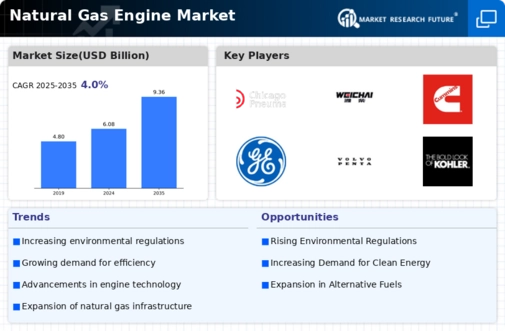Market Growth Projections
The Global Natural Gas Engine Market Industry is projected to experience substantial growth over the coming years. In 2024, the market is valued at 6.08 USD Billion, with expectations to reach 9.36 USD Billion by 2035. This growth trajectory indicates a CAGR of 4.0% from 2025 to 2035, reflecting the increasing adoption of natural gas engines across various sectors. Factors such as technological advancements, government support, and rising demand for cleaner energy solutions are likely to drive this growth. The market's expansion is indicative of a broader shift towards sustainable energy practices globally.
Growing Industrial Applications
The Global Natural Gas Engine Market Industry is experiencing growth due to the increasing adoption of natural gas engines in various industrial applications. Industries such as mining, construction, and agriculture are recognizing the benefits of using natural gas engines for their equipment and machinery. These engines offer lower operational costs and reduced emissions, making them an attractive option for businesses aiming to enhance sustainability. As industries continue to seek efficient and environmentally friendly solutions, the demand for natural gas engines is expected to rise, further contributing to the market's expansion.
Government Incentives and Support
Government incentives and support play a crucial role in the expansion of the Global Natural Gas Engine Market Industry. Many countries are implementing policies that promote the use of natural gas as a cleaner alternative to fossil fuels. These initiatives often include tax breaks, subsidies, and grants for companies investing in natural gas engine technologies. For instance, various governments are establishing programs to encourage the adoption of natural gas vehicles, which is expected to drive market growth. Such supportive measures not only foster innovation but also create a favorable environment for the development and deployment of natural gas engines.
Rising Infrastructure Development
The expansion of infrastructure for natural gas distribution is a key driver for the Global Natural Gas Engine Market Industry. As more countries invest in natural gas pipelines and refueling stations, the accessibility and feasibility of using natural gas engines increase. This infrastructure development is particularly evident in emerging economies, where the demand for reliable and cleaner energy sources is growing. Enhanced infrastructure not only supports the adoption of natural gas engines in transportation but also facilitates their use in industrial applications, thereby broadening the market's scope and potential.
Increasing Demand for Clean Energy Solutions
The Global Natural Gas Engine Market Industry is witnessing a surge in demand for cleaner energy alternatives as countries strive to reduce greenhouse gas emissions. Natural gas engines, known for their lower emissions compared to traditional diesel engines, are becoming increasingly popular in various sectors, including transportation and power generation. In 2024, the market is projected to reach 6.08 USD Billion, driven by stringent environmental regulations and a global shift towards sustainable energy practices. This trend is expected to continue, as governments and industries prioritize investments in cleaner technologies, thereby enhancing the market's growth potential.
Technological Advancements in Engine Efficiency
Technological innovations in natural gas engines are significantly enhancing their efficiency and performance, thereby propelling the Global Natural Gas Engine Market Industry. Advances such as turbocharging, improved fuel injection systems, and electronic control units are enabling engines to operate more efficiently, reducing fuel consumption and emissions. These improvements not only make natural gas engines more appealing to consumers but also align with global sustainability goals. As a result, the market is anticipated to grow at a CAGR of 4.0% from 2025 to 2035, reaching an estimated 9.36 USD Billion by 2035, reflecting the industry's commitment to innovation and efficiency.













